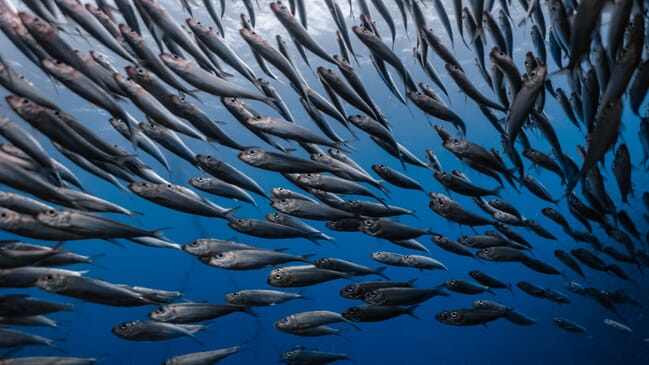
The study was published this week Nature Food and focuses on the flow of nutrients from the edible species of wild fish used as feed, to the farmed salmon they were fed to. The researchers found a decrease in six out of nine nutrients in the salmon fillet – calcium, iodine, iron, omega-3, vitamin B12 and vitamin A – but increased levels of selenium and zinc.
Most wild forage fish met dietary nutrient recommendations at smaller portion sizes than farmed Atlantic salmon, including omega-3 fatty acids which are known to reduce the risk of cardiovascular disease and stroke.
“What we’re seeing is that most species of wild fish used as feed have a similar or greater density and range of micronutrients than farmed salmon fillets,” said lead author, Dr David Willer, from the University of Cambridge in a press release.
“Whilst still enjoying eating salmon and supporting sustainable growth in the sector, people should consider eating a greater and wider variety of wild fish species like sardines, mackerel and anchovies, to get more essential nutrients straight to their plate,” he added.
In the UK, 71 percent of adults have insufficient vitamin D in winter, and teenage girls and women often have deficiencies of iodine, selenium and iron. Yet while, 24 percent of adults ate salmon weekly, only 5.4 percent ate mackerel, 1 percent anchovies and just 0.4 percent herring.
“Making a few small changes to our diet around the type of fish that we eat can go a long way to changing some of these deficiencies and increasing the health of both our population and planet,” said Willer.
The researchers found consuming one-third of current food-grade wild feed fish directly would be the most efficient way of maximising nutrients from the sea.
“Marine fisheries are important local and global food systems, but large catches are being diverted towards farm feeds. Prioritising nutritious seafood for people can help improve both diets and ocean sustainability,” said senior author Dr James Robinson, from Lancaster University.
This approach could help address global nutrient deficiencies say the team of scientists from the University of Cambridge, Lancaster University, University of Stirling and the University of Aberdeen.
How their conclusions were reached
The scientists calculated the balance of nutrients in edible portions of whole wild fish, used within pelleted salmon feed in Norway, compared to the farmed salmon fillets.
They focused on nine nutrients that are essential in human diets and concentrated in seafood – iodine, calcium, iron, vitamin B12, vitamin A, omega-3 (EPA + DHA), vitamin D, zinc and selenium.
The wild fish studied included Pacific and Peruvian anchoveta, and Atlantic herring, mackerel, sprat and blue whiting – which are all marketed and consumed as seafood.
They found that these six feed species contained a greater, or similar, concentration of nutrients as the farmed salmon fillets. Quantities of calcium were over five times higher in wild feed fish fillets than salmon fillets, iodine was four times higher, and iron, omega-3, vitamin B12, and vitamin A were over 1.5 times higher.
Wild feed species and salmon had comparable quantities of vitamin D.
Zinc and selenium were found to be higher in salmon than the wild feed species – the researchers say these extra quantities are due to other salmon feed ingredients and are a real mark of progress in the salmon sector.
“Farmed salmon is an excellent source of nutrition, and is one of the best converters of feed of any farmed animal, but for the industry to grow it needs to become better at retaining key nutrients that it is fed. This can be done through more strategic use of feed ingredients, including from fishery by-products and sustainably-sourced, industrial-grade fish such as sand eels”, said Dr Richard Newton of the Institute of Aquaculture, University of Stirling, whose team also included Professor Dave Little, Dr Wesley Malcorps and Björn Kok.
“It was interesting to see that we’re effectively wasting around 80 percent of the calcium and iodine from the feed fish – especially when we consider that women and teenage girls are often not getting enough of these nutrients”.
Willer added: “These numbers have been underacknowledged by the aquaculture industry’s standard model of quoting fish in fish out (FIFO) ratios rather than looking at nutrients.
The researchers would like to see a nutrient retention metric adopted by the fishing and aquaculture industries. They believe that if combined with the current FIFO ratio, the industry could become more efficient, and reduce the burden on fish stocks that also provide seafood. The team are building a standardised and robust vehicle for integrating the nutrient retention metric into industry practice.
“We’d like to see the industry expand, but not at a cost to our oceans,” said Willer.
“We’d also like to see a greater variety of affordable, convenient and appealing products made of wild ‘feed’ fish and fish and salmon by-products for direct human consumption.”
The research was funded by the Scottish Government’s Rural and Environmental Science and Analytical Services Division (RESAS), a Royal Society University Research Fellowship, a Leverhulme Trust Early Career Fellowship a Henslow Fellowship at Murray Edwards College and the University of Cambridge.




